无溶剂微波萃取法和水蒸馏法提取芫荽叶精油:化学成分的比较分析,体外和硅法
IF 6.6
1区 农林科学
Q1 FOOD SCIENCE & TECHNOLOGY
引用次数: 0
摘要
芫荽精油(EO)由于其各种药用和芳香特性,骨叶具有显著的潜力。本研究旨在比较无溶剂微波萃取法(SFME)和加氢蒸馏萃取法(HDE)两种不同提取方法对芫花叶中精油的提取效率。FTIR分析发现了C- h、C=C、-OH和C=O等官能团,表明羰基化合物、羟基化合物、烷烃和烯烃的存在。GC/MS分析共鉴定出37个化合物,主要成分为异油烯(SFME-23.916±0.178 %,HDE-25.332±0.232 %)、β-蒎烯(SFME-10.662±0.040 %,HDE-11.302±0.010 %)、α-蒎烯(SFME-12.699±0.239 %,HDE-9.755±0.125 %)和α-依兰烯(SFME-10.246±0.167 %,HDE-10.318±0.085 %)。SFME的抗氧化活性、总酚含量和总黄酮含量(IC50分别为13.511±0.102 ppm、2.557±0.138 mg GAE/g、3.383±0.125 mg QCE/g)均高于HDE (IC50分别为16.031±0.121 ppm、1.235±0.110 mg GAE/g和3.249±0.022 mg QCE/g)。通过测定抑菌区(ZOI)和最低抑菌浓度(MIC)来评价其抑菌活性。SFME萃取的EO对金黄色葡萄球菌的抑制作用最高(ZOI-17.50±1.87 mm, MIC-3.10 μL/mL),而HDE对金黄色葡萄球菌的抑制作用最高(ZOI-12.83±1.03 mm, MIC-6.20 μL/mL)。分子对接研究也与抗菌试验结果相关。通过对比研究,证明了SFME是一种有效提取芫荽叶精油的有效方法。本文章由计算机程序翻译,如有差异,请以英文原文为准。

Solvent-free microwave extraction and hydrodistillation extraction of essential oils from Syzygium cumini leaves: Comparative analysis of chemical constituents, in vitro and in silico approaches
The essential oil (EO) from Syzygium cumini (L.) Skeels leaves holds significant potential due to its various medicinal and aromatic properties. The present study aimed to compare efficiency of EO extraction from S. cumini leaves using two distinct methods: solvent-free microwave extraction (SFME) and hydrodistillation extraction (HDE). Functional groups such as C-H, C=C, -OH and C=O were revealed by FTIR analysis, suggesting the existence of carbonyl compounds, hydroxyl compounds, alkanes, and alkenes. The GC/MS analysis identified total thirty-seven compounds where major components were isoledene (SFME-23.916 ± 0.178 %, HDE-25.332 ± 0.232 %), β-Pinene (SFME-10.662 ± 0.040 %, HDE-11.302 ± 0.010 %), α-Pinene (SFME-12.699 ± 0.239 %, HDE-9.755 ± 0.125 %) and α-ylangene (SFME-10.246 ± 0.167 %, HDE-10.318 ± 0.085 %). The antioxidant activity, total phenolic content and total flavonoid content of SFME were relatively higher (IC50 13.511 ± 0.102 ppm, 2.557 ± 0.138 mg GAE/g, 3.383 ± 0.125 mg QCE/g) than HDE (IC50 16.031 ± 0.121 ppm, 1.235 ± 0.110 mg GAE/g and 3.249 ± 0.022 mg QCE/g). The antimicrobial activity was evaluated by measuring zone of inhibition (ZOI) and minimum inhibitory concentration (MIC). EO extracted by SFME showed highest against bacteria S. aureus (ZOI-17.50 ± 1.87 mm, MIC-3.10 μL/mL) compared to HDE where ZOI-12.83 ± 1.03 mm, MIC-6.20 μL/mL for S. aureus. Molecular docking study also correlates antimicrobial test results. This comparative study demonstrates SFME as a promising method for efficiently obtaining quality essential oil from S. cumini leaves.
求助全文
通过发布文献求助,成功后即可免费获取论文全文。
去求助
来源期刊

LWT - Food Science and Technology
工程技术-食品科技
CiteScore
11.80
自引率
6.70%
发文量
1724
审稿时长
65 days
期刊介绍:
LWT - Food Science and Technology is an international journal that publishes innovative papers in the fields of food chemistry, biochemistry, microbiology, technology and nutrition. The work described should be innovative either in the approach or in the methods used. The significance of the results either for the science community or for the food industry must also be specified. Contributions written in English are welcomed in the form of review articles, short reviews, research papers, and research notes. Papers featuring animal trials and cell cultures are outside the scope of the journal and will not be considered for publication.
 求助内容:
求助内容: 应助结果提醒方式:
应助结果提醒方式:


